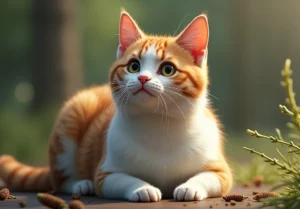Have you ever wondered why cat whiskers are so sharp? They seem almost like little needles, but what purpose do they serve, and why are they designed this way?
Evolution of Cat Whiskers
Cat whiskers have come a long way since the dawn of feline evolution. Back in the day, these whiskers weren’t just tools for looking fabulous – they served a crucial role in helping our feline friends navigate their surroundings and detect prey. As cats evolved and adapted to their environments, their whiskers grew in length and sensitivity to enhance their survival skills.
Interestingly, the whisker follicles are packed with nerves, making them highly sensitive to even the slightest touch or movement. This sensitivity allows cats to detect changes in the air currents around them, helping them navigate through dimly lit environments with ease. It’s like having a built-in GPS system, but way more stylish!
Anatomy of Cat Whiskers
Let’s dive into the nitty-gritty of cat whiskers – these specialized facial hairs are not your average fur! Unlike regular fur, cat whiskers are thick, rigid, and deeply rooted in the cat’s body, making them much sturdier than the rest of their coat. This unique structure allows whiskers to bend and flex without breaking, giving cats an edge in their sensory capabilities.
The secret behind the sharpness of cat whiskers lies in the specialized sensory organs located at the base of each whisker. These organs, known as proprioceptors, send information to the cat’s brain about the position and movement of their whiskers. This helps cats gauge the size of openings, navigate through tight spaces, and even detect subtle changes in their environment – all thanks to those sharp whiskers!
Fun Fact: Cat whiskers are so sensitive that they can even pick up faint vibrations, making cats excellent hunters and agile predators. So next time you see a cat with whiskers twitching, you know they’re in predator mode, ready to pounce!
Role in Hunting Behavior
Cat whiskers are not just fashionable accessories; they actually serve a vital purpose in a cat’s hunting behavior. These whiskers are like a built-in GPS system for cats, helping them navigate through the dark and dense areas where their prey may be hiding. When a cat stalks its prey, those sharp whiskers sense even the slightest movement in the air, aiding in capturing their target with precision. So, next time you see a cat with those sharp, fierce whiskers, remember they are essential tools for survival in the wild.
Sensory Perception
It’s not just about looking good; a cat’s whiskers are ultra-sensitive sensory hairs that provide them with a heightened awareness of their surroundings. These whiskers are so finely tuned that they can detect changes in air currents, temperature, and even the size of openings. This exceptional sensitivity helps cats avoid potential dangers like predators or narrow spaces where they might get stuck. So, when your feline friend seems to be scanning the room with those whiskers, they’re actually taking in a wealth of information that keeps them safe and aware.
Additional Insight:
– Cat whiskers can also help determine an object’s size and shape, facilitating a cat’s ability to assess if they can fit through a particular space or if their prey is within striking distance. So, those sharp whiskers are like a feline radar system, giving cats a unique advantage in their environment.
Communication Tool
Cat whiskers are not just for decoration – they serve as a vital tool for communication. When a cat interacts with other animals or humans, their whiskers play a key role in conveying important information. Through subtle movements and positions, cats can express their mood, intentions, and even establish boundaries. So, the next time your feline friend brushes their whiskers against you, understand that they are trying to communicate something meaningful.
Maintenance and Care
Caring for your cat’s whiskers is essential to ensure they remain sharp and functional for their daily activities. To keep them in top condition, avoid trimming or cutting them, as whiskers are incredibly sensitive and cutting them can be painful for your cat. Make sure your cat has enough space to move around without damaging their whiskers, and regularly check their whiskers for any signs of damage or irritation. By keeping your cat’s whiskers well-maintained, you are helping them navigate the world with ease and grace.
- Provide your cat with a balanced diet rich in essential nutrients to promote healthy whisker growth.
- Avoid playing with or tugging on your cat’s whiskers, as this can cause discomfort and may damage them over time.
- Regularly groom your cat to prevent any debris or dirt from accumulating in their whiskers, which could affect their sensitivity and functionality.
Unique Characteristics
Cat whiskers are much more than just adorable features on your feline friend’s face. These specialized hairs, known as vibrissae, are incredibly sensitive and serve several important functions. Unlike regular hair, whiskers are deeply embedded in a cat’s body, connected to nerve endings that can detect even the slightest changes in their surroundings. This heightened sensitivity helps cats navigate and explore their environment effectively, aiding in hunting, sensing movement, and determining if they can fit through tight spaces. Additionally, the sharpness of cat whiskers comes from their composition, which is thicker and more rigid than typical hair, allowing them to maintain their shape and provide accurate information to the cat.
Cat Whiskers in Mythology and Culture
In various mythologies and cultures around the world, cat whiskers hold significant symbolic importance. For example, in Japanese folklore, the “Maneki-neko” or beckoning cat figurine is often depicted with its paw raised and adorned with long whiskers. This iconic image is believed to bring good luck and prosperity to its owner. In some cultures, cat whiskers are associated with wisdom, intuition, and mysticism, highlighting the reverence and awe these whiskers have inspired over the centuries. The inclusion of cat whiskers in art, literature, and even superstitions showcases the enduring fascination with these unique feline features.
Extra insight:
Adding to their sensory abilities, cat whiskers are not just found on the face but also on the backs of a cat’s front legs. These leg whiskers, called carpal whiskers, help cats gauge the size of openings and judge distances accurately, contributing to their remarkable agility and grace.
Alex, a passionate animal lover, has experience in training and understanding animal behavior. As a proud pet parent to two dogs and three cats, he founded AnimalReport.net to share insights from animal experts and expand his knowledge of the animal kingdom.




